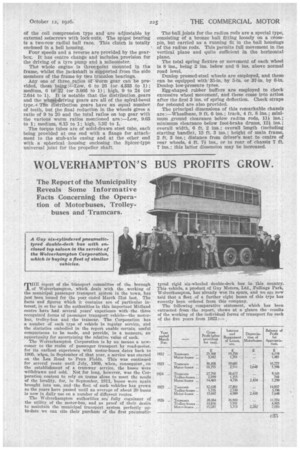WOLVERHAMPTON'S BUS PROFITS GROW.
Page 57

Page 58

If you've noticed an error in this article please click here to report it so we can fix it.
MIZE report of the transport committee • of the borough
of Wolverhampton, Which deals with the working of the municipal passenger transport system in the town, has just been issued for the year ended March 31st last. The facts and ,figures -Which it Contains are of particular interest, in so far as the authorities in this important Midland centre have had several years' experience with the. three recognized forms of passenger transportvehicle-the motorbus, trolley-bus and the tramcar. The Corporation has
number of each type of vehicle in regular service, and the statistics embodied in the report enable certain useful comparisons to be made, and provide; in a measure, an opportunity for ascertaining the relative value of each.
The Wolverhampton Corporation is by no means a newcoiner to the realm of passenger transport by road-motor, for its earliest experience with motor-buses dates back to 1905. when, in September of that Year, a service was started on the Lea Road to Penn Fields. This -was continued far several years until July, 1909, when, consequent, an the establishment of a tramway service, the buses were withdrawn and sold. Not for long, however, was the Corporation content to rely on trains alone to meet the needs of the locality, for, in September, 1911, buses were again brought into use, and the fleet of such vehicles has grown as the years have passed until an average of about 30 buses is now in daily use on a number of different routes.
The Wolverhampton authorities are' fully cognizant of the utility of the motor-bus, • and as proof of their desire to maintain the municipal transport system perfectly upto-date we can cite their purchase Of the" first 'pneumatic tyred rigid six-wheeled double-deck bus in this country. This-vehicle, a product of Guy Motors, Ltd., Fallings Park, Wolverhampton, has already won its spurs, and we are now told that a fleet .of a further eight buses of this type has recently been ordered from this company.
The following comparative statement, which has been extracted from -the report, shows at a glance the results of the working of tho individual forms of transport for each of the five years from 1922:. It will be seen that the gross profit on both Ihe buses and trolley-buses has shown a useful advance erten year.
The gross profit for the past year on the motorbus account was 116,260, on the trolley-bus account £11,074, and on the tramways account £31,264, representing a total of 158,598. After debiting interest on capital, repayment of loans, reserve for income-tax on profits and certain other items, a net profit of 123,769 is left, and the appropriation of this sum includes 110,828 allocated to the reserve and renewals fund which, at the end of the past year's working, stood at £33,510.
Some idea of the importance of the municipal passenger transport system at Wolverhampton can be gained from the fact that the population of the area which is served is close on 340,000. The average number of vehicles in daily use during the past year was 27 buses, 16 trolleybuses and 30 tramcars, although the actual number of each type owned by the Corporation at the end of the period covered by" the report was 36, 26 and 46 respectively, so that ample vehicles are available to meet any unexpected heed. A considerable sum of money is mink in the system, the gross capital expenditure on buses having ken £50,661, on trolley-buses 194,343, and on trans 1383,136.
So far as statistics relating to the last year's working cf the transport undertaking are concerned, we cannot do better than publish, in tabular form, the figures dealing with each system, for in this way the reader can make his own comparisons and formulate his own conclusions.
So far as the average fare charged per mile is concerned the figures are calculated on the Ministry of Transport formula. In the case of the average fare paid per passenger the figures are arrived at before dedneting an amount for buses running over tramcar routes.
An analysis of the motorbus account shows that an exPenditure of 152,303 was incurred under the following headings :—maintenance and repairs, /8,980; traffic, £28,044; fuel, £10,175; general, £5,027; driving tuition, £77. Wages of drivers and conductors were responsible for the largest disbursement under any section, the total of £18,713 being equivalent to 4.370d. per bus-mile out of total expenditure of 12215d. per bus-mile.
A review of the trolley-bus account shows that the detailed expenditure was as follows :—maintenance and re
pairs, 13,460; traffic expenses, 113,954; power, £3,987; general expenses, £4,334; driving tuition, 114---a total of £25,749. Here again a big amount was absorbed by the payment of drivers' and conductors' wages, the sum of £9,364 being equivalent to 4.003d per bus-mile out of total expenditure of 11.006d. per bus-mile.
number of passengers carried en the buses during the year 32 per cent. paid Id. and lid, fares, whereas on the trolley vehicle and tramcars the percentage of passengers paying similar fares was 56 and 53 respectively. Charts which are contained in the report indicate that the higher the fare the greater the perentage of passengers using the buses, a state of affairs which suggests that a discerning public appreciates the riding comfort afforded by the petrol-propelled road motor on journeys of some length.
The report is well prepared and the information it contains is lucidly put together. We must mention that Mr. C. Owen Silvers, A.M.I.E.E., M.Inst.T., is the general manager and engineer of the municipal transport department at Wolverhampton. Of the total












































































































